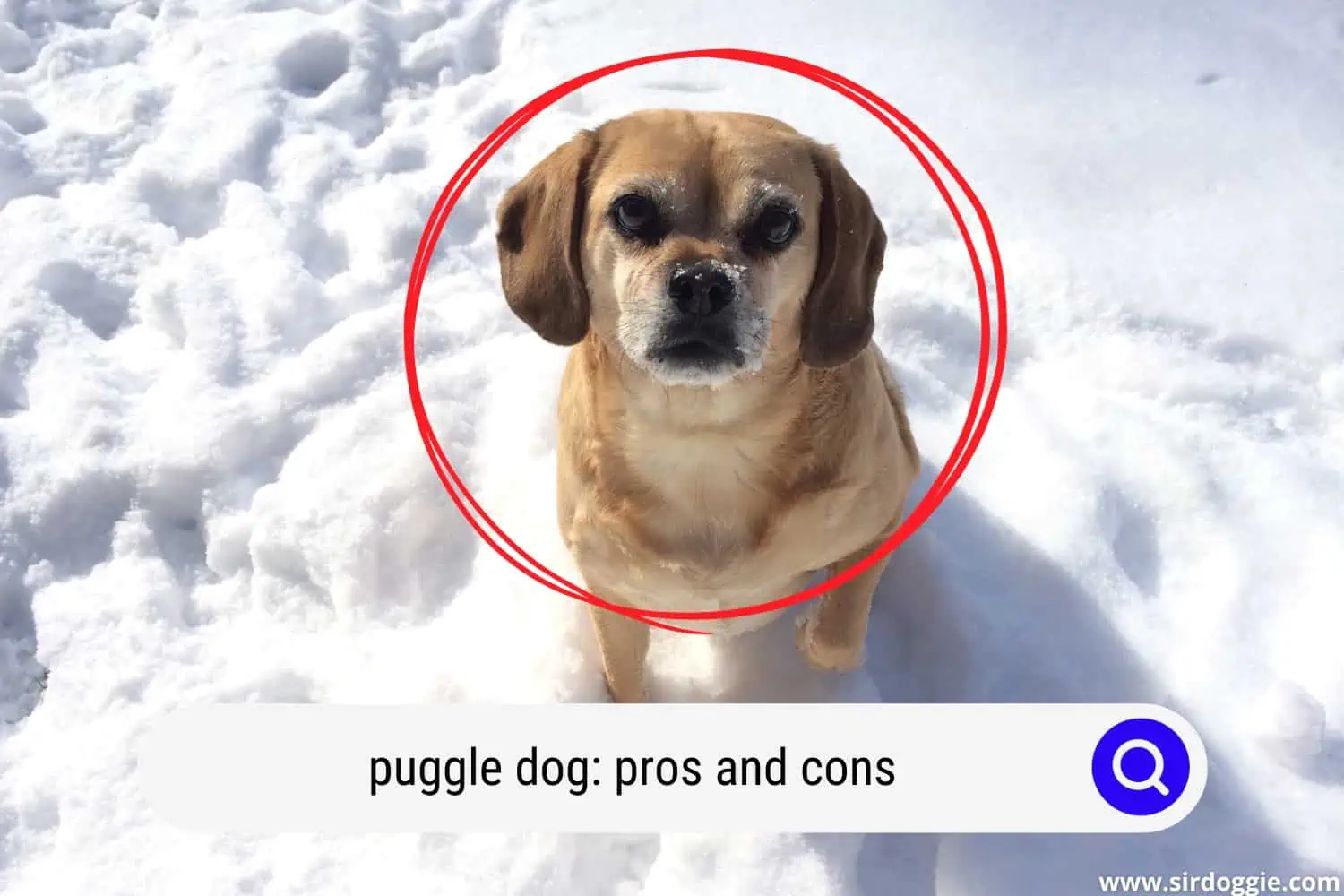Pros and Cons Of A Puggle: Is It The Right Breed For Me?
If you are looking for a companion dog and have heard about the Puggle breed, but don’t know much about it, read on! Each breed has its pros and cons, therefore you have to look into both before you acquire a furry pal. A lot depends on what your lifestyle is, how active you are, and how much time you can devote to a new fluffy friend so it doesn’t feel lonely during the day.
In case you are very outdoorsy, social, and outgoing, a Puggle pooch might suit you perfectly. However, you might want to take a look at both pros and cons of a Puggle to determine if this kind of mutt can be up your alley.
Hence, let’s get right to it! And we’ll start with a little history lesson on this very peculiar canine species.

A Little Bit About A Puggle Breed
So who exactly is a Puggle hound? As the name suggests: the first half is a “Pug” and the other one is a “Gle,” taken from the “Beagle” breed. Therefore, a Puggle is a mix of both a Pug and a Beagle.
Puggles have a lot of the former parent’s features, including their big, bug-like eyes. However, its muzzle is much more elongated compared to Pugs. So, why were two very different canines mixed?
The reason is to help brachycephalic wrinkle faces straighten out their breathing issues and re-create a much healthier pal in the end.
Puggle is a hybrid, therefore it might be hard to say who it is going to take after as far as appearance, health, and temperament are concerned. More often than less, it will inherit its flat-faced ancestor’s facial features, but you will still see a longer, Beagle-like snout. However, as far as the health issues, it is hard to say which of them a Puggle will inherit from either parent.
As far as their size: they will be bigger than an average Pug. Their height can be anywhere from 8 to 14 inches and the weight is in the 15-30 pounds range. A male is usually larger than a female, with the latter being a few inches shorter and several pounds lighter.
Puggle’s eye color is pretty predictable: their peepers are usually brown with a very rare exception of hazel and/or blue. Coat color? Puggles have inherited a short, prone to shedding mane in the black, white, fawn, or red color palette. It is normally very dense and needs to be brushed out often, at least a few times per week.
And now, let’s dig into the history of our Puggle species. Where did it all begin for them?
Historical Facts About Puggles
These fellas have both Asian and European blood running through their veins. Makes perfect sense: a Pug parent is from the Celestial Empire (China) and a Beagle is an ideal “Englishman.” To be exact, the latter originated in 16th-century England and was a hit with most reigning British monarchs.
They were perfect hunter dogs, who would prey on small animals like rodents, rabbits, and chipmunks. Whereas the former was deeply cherished by the Chinese nobility.
Pugs were designed to be perfect royal companions, confidantes, and lapdogs who love to cuddle with their masters. Do Pugs need a lot of attention? Yes, most certainly! They’ve always wanted to be the superstar of the family, nothing changed since ancient times.
Beagle was first crossbred with a Pug in 1980, by a “designer dog” breeder Wallace Havens located in the state of Wisconsin. He had extensive breeding experience by the time he developed the modern Puggle breed we love and adore today.
Now, let’s take a look at some common pros and cons of a Puggle for you to determine if it’s the right breed for you.
Pros And Cons Of A Puggle: Are Puggles Good Dogs?
Pros
Puggles have great temperaments! Both Pug and Beagle ancestors are very good family dogs. Therefore a Puggle inherits double the goodness. They do great in households with kids and other canine siblings. Puggle pooches are excellent huggers, kissers, and companions, therefore are recommended for older people who are retired and sometimes tend to feel lonely.
Very suitable for owners who are always out and about. Puggles get their inquisitive spirit from a Beagle parent, who is a very socially active canine. A Puggle pup will become your “partner in crime” when it comes to being outdoorsy.
This breed will do very well in dog parks, hiking, and doggy daycares as well!
It inherits the wits from both parent breeds and, therefore is fairly easy to train. Even more so if a training session is accompanied by some high-value treats! An owner has to be a good leader for a Puggle pooch to follow. Positive reinforcement works best with any type of dog, including the long-muzzled hounds we are discussing.
This designer dog is very compact and will be suitable for any type of household, be it a huge mansion or a tiny studio apartment. That makes it a perfect pet if you ask me! All it needs is just a little space where it can go rest, sleep, and play, that’s it.
Since it’s a very friendly, easy-going, smart, and cuddly dog, it will be great for those people who want to become pet parents for the first time.
Cons
Be prepared to brush this mutt out every other day, especially in the spring. It needs to be prepared for the warmer weather ahead, so it will start to get rid of the old coat rather quickly. I suggest investing in a good de-shedding brush to help you in your combing endeavor.
Puggles tend to get the same types of ailments that their ancestors had. For instance, Pug’s lung, eye, joint, cardiovascular, and thyroid problems. A Beagle gives them epilepsy, cherry eye, hypothyroidism, and endless ear infections. Hence, as you can see, caring for a Puggle pal can be costly!
If you cherish your good night’s sleep and were asking yourself “Do Puggles bark a lot?” before getting a Puggle pup, an answer would be yes, they do. Does a squirrel pass by? Is your mailman trying to make you sign for a certified letter? Barking session guaranteed! They also howl like a wolf if they are being left alone for a while.

Curl-Up
After reviewing both the pros and cons of a Puggle we’ve just covered, it is up to you whether or not to go that canine route. It all depends on what type of person you are, what your work schedule looks like, and what your expectations are when it comes to choosing a fluffy friend for life. Just remember: don’t rush into any decisions, sleep on it. Because getting a puppy requires personal maturity, a sense of responsibility as well as an ability to give love unconditionally.
Related Reading: Puggle’s Willful Temperament: Tips On Taming Your Unruly Fur Baby

Family Dog Expert Author
Hi there! I’m Stuart, a devoted dog lover and family dog expert with over a decade of experience working with our furry companions. My passion for dogs drives me to share my knowledge and expertise, helping families build strong, loving bonds with their four-legged friends. When I’m not writing for SirDoggie, you’ll find me hiking, playing with my beautiful dog, or studying music.
